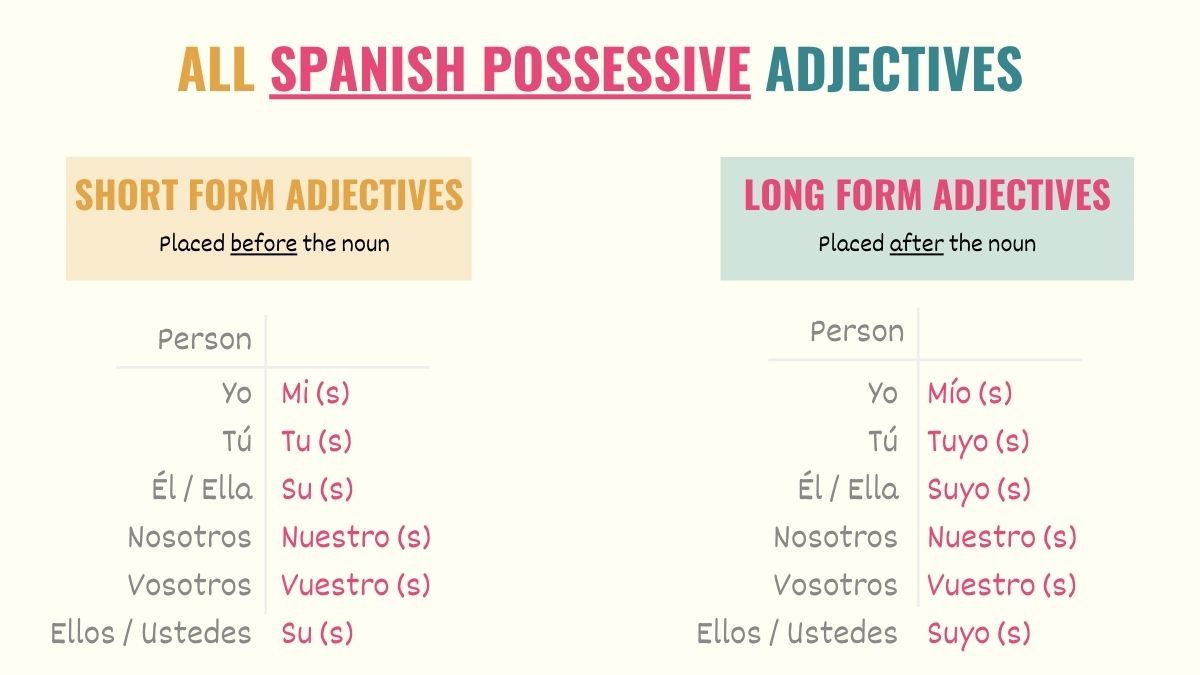Bosque de Palabras
Bosque de Palabras is a text adventure survival game designed to help you learn Spanish vocabulary and grammar while having fun!
In Bosque de Palabras, you're camping️ in the middle of a dark forest, with only a few pieces of food left and a campfire keeping you warm. Every choice you make is important for your survival.
Perfect for: Novice and Intermediate level Spanish learners.
A Complete Guide to Master Spanish Pronouns
Gordon Feliz • Updated Feb 27th, 2024


Apprendre en français

Aprender em Português
Welcome to our complete guide on Spanish pronouns! We're diving into the nine essential types, from the basics like subject pronouns to the more nuanced prepositional pronouns. After a quick look at one type, we're excited to journey through the rest together. So, let's get started!
Understanding Spanish Pronouns
Spanish pronouns are handy tools, stepping in for nouns to keep our conversations and writings crisp and engaging.
Whether it’s to talk about people, places, or things, these pronouns help us communicate with ease and efficiency.
Brief Introduction to the Nine Types
Subject Pronouns: These little words tell us who's in the spotlight of the sentence, often replacing names to keep things flowing smoothly.
Direct Object Pronouns: They take the baton from the direct object, the main recipient of the action, making our sentences leaner and meaner.
Indirect Object Pronouns: These pronouns shine a light on the indirect object, the one benefiting from the verb’s action, ensuring clarity and brevity.
Reflexive Pronouns: It’s all about self-reflection here, as these pronouns show actions that circle back to the subject.
Possessive Pronouns: Claiming ownership or association? Possessive pronouns have got your back.
Demonstrative Pronouns: Pointing out specific things? Demonstrative pronouns are your go-to.
Relative Pronouns: Linking clauses and thoughts seamlessly? That’s the job of relative pronouns.
Indefinite Pronouns: For times when specifics are either unnecessary or unknown, indefinite pronouns step in.
Prepositional Pronouns: Adding layers of meaning to prepositions, these pronouns help in fine-tuning our expressions.
Subject Pronouns
Subject Pronouns make it clear who's doing what, often allowing us to skip the pronoun altogether thanks to the magic of verb conjugations.
Subject Pronoun English Translation
- Yo I
- Tú You (informal singular)
- Él/Ella/Usted He/She/You (formal singular)
- Nosotros/Nosotras We
- Vosotros/Vosotras You (informal plural in Spain)
- Ellos/Ellas/Ustedes They/You (formal plural)
Direct Object Pronouns tidy up sentences by removing repetition, placed snugly before the verb.
- Me (Me)
- Te (You - informal singular)
- Lo/La (Him/Her/It/You - formal singular)
- Nos (Us)
- Os (You - informal plural in Spain)
- Los/Las (Them/You - formal plural)
Indirect Object Pronouns, the messengers of benefit or impact, also precede the verb, ensuring the sentence flows smoothly.
- Me (To/For me)
- Te (To/For you - informal singular)
- Le (To/For him/her/it/you - formal singular)
- Nos (To/For us)
- Os (To/For you - informal plural in Spain)
- Les (To/For them/you - formal plural)
Using Reflexive Pronouns in Spanish (Pronombres Reflexivos)
Reflexive pronouns are essential in Spanish when the subject and object of a sentence are the same, indicating that the action is done by the subject to themselves.
Tip: Place the reflexive pronoun before the verb. For actions in the infinitive or gerund, you can position it before the main verb or attach it directly to the end of these forms.
These pronouns are your go-to for actions related to self-care or daily activities. Here's a quick list:
- Me: Myself
- Te: Yourself (informal singular)
- Se: Himself/Herself/Itself/Yourself (formal singular)
- Nos: Ourselves
- Os: Yourselves (informal plural in Spain)
- Se: Themselves/Yourselves (formal plural)
Examples to get you started:
"Me lavo las manos." (I wash my hands.)
"Nos despertamos temprano." (We wake up early.)
"Te ves bien." (You look good.)
Mastering Possessive Pronouns (Pronombres Posesivos)
Possessive pronouns in Spanish show who something belongs to.
Remember: These pronouns must match the gender and number of the noun they're replacing.
Tip: Use these pronouns to replace a noun once it's clear who or what you're talking about, ensuring they agree in gender and number.
Here are the possessive pronouns you need to know:
- Mío/a/os/as: Mine
- Tuyo/a/os/as: Yours (informal singular)
- Suyo/a/os/as: His/Hers/Its/Yours (formal singular and plural)
- Nuestro/a/os/as: Ours
- Vuestro/a/os/as: Yours (informal plural in Spain)
- Suyo/a/os/as: Theirs
See them in action:
"El libro es mío." (The book is mine.)
"¿Dónde está tu casa? La mía está al lado." (Where is your house? Mine is next door.)
"Nuestros amigos llegaron tarde." (Our friends arrived late.)

Pointing Things Out with Demonstrative Pronouns (Pronombres Demostrativos)
Demonstrative pronouns in Spanish help you specify items or people.
Tip: These pronouns replace nouns and must agree in gender and number.
There are three categories to remember:
- Este/a/os/as: This/These (close by)
- Ese/a/os/as: That/Those (a bit further)
- Aquel/la/llos/llas: That/Those over there (far away)
Examples:
"Quiero comprar esa camisa." (I want to buy that shirt.)
"Estos zapatos son muy cómodos." (These shoes are very comfortable.)
"Aquella casa es muy bonita." (That house over there is very beautiful.)
Connecting Ideas with Relative Pronouns (Pronombres Relativos)
Relative pronouns in Spanish link clauses and sentences, adding depth to your conversations.
Tip: These pronouns should match the noun they refer to in gender and number, with the choice depending on the sentence context.
Essential relative pronouns include:
- Que: That, who, which
- Quien/es: Who, whom
- El que/la que/los que/las que: The one(s) who
- Cuyo/a/os/as: Whose
- Donde: Where
- Lo que: What, that which
In practice:
"La chica que está allí es mi hermana." (The girl there is my sister.)
"El libro que compré es interesante." (The book I bought is interesting.)
"La casa donde crecí está en España." (The house where I grew up is in Spain.)
Expressing Generalities with Indefinite Pronouns (Pronombres Indefinidos)
Indefinite pronouns are vague, referring to non-specific people or things, perfect for when details aren't necessary.
Tip: Adjust your choice based on the sentence's context, considering number and gender.
Key indefinite pronouns include:
- Alguien: Someone
- Algo: Something
- Nadie: No one
- Nada: Nothing
- Todo: Everything, all
- Todos: Everyone
- Alguno/a/os/as: Some, any
- Ninguno/a: None, not any
Examples:
"Alguien dejó su paraguas." (Someone left their umbrella.)
"No quiero nada para mi cumpleaños." (I don’t want anything for my birthday.)
"Todos están invitados." (Everyone is invited.)
Navigating Prepositions with Prepositional Pronouns (Pronombres Preposicionales)
Prepositional pronouns in Spanish follow prepositions, indicating involvement in actions.
Tip: Always use these after prepositions, ensuring they match the noun's gender and number.
Familiarize yourself with these pronouns:
- Mí: Me
- Ti: You (informal singular)
- Él/Ella: Him/Her
- Nosotros/as: Us
- Vosotros/as: You all (informal)
- Ustedes: You all (formal)
- Ellos/Ellas: Them
Examples:
"El libro es para mí." (The book is for me.)
"Voy a la tienda con ella." (I’m going to the store with her.)
Pronoun Language Learning Exercises
Below are some language learning exercises focusing on the use of Spanish pronouns, providing helpful examples for each type discussed. These exercises are designed to demonstrate how each pronoun type functions within a sentence, offering a clear model for understanding and application.
Reflexive Pronouns (Pronombres Reflexivos)
"Ella se mira en el espejo." = "She looks at herself in the mirror."
"Nos levantamos temprano cada mañana." = "We wake up early every morning."
"¿Te acuerdas de mí?" = "Do you remember me?"
Possessive Pronouns (Pronombres Posesivos)
"Ese coche es mío." = "That car is mine."
"¿Son estos libros tuyos?" = "Are these books yours?"
"La casa de ellos es muy grande." = "Their house is very big."
Demonstrative Pronouns (Pronombres Demostrativos)
"Esta pluma escribe bien." = "This pen writes well."
"Esos zapatos son muy caros." = "Those shoes are very expensive."
"Aquellos árboles son altos." = "Those trees over there are tall."
Relative Pronouns (Pronombres Relativos)
"El hombre que vimos ayer es mi vecino." = "The man whom we saw yesterday is my neighbor."
"La película que me gustó ganó un premio." = "The movie that I liked won an award."
"El parque donde jugábamos está cerrado." = "The park where we used to play is closed."
Indefinite Pronouns (Pronombres Indefinidos)
"Alguien dejó una nota en la puerta." = "Someone left a note on the door."
"Necesito algo de beber." = "I need something to drink."
"Todos están invitados a la fiesta." = "Everyone is invited to the party."
Prepositional Pronouns (Pronombres Preposicionales)
"Este regalo es para ti." = "This gift is for you."
"Estoy hablando de él." = "I am talking about him."
"El libro está entre ella y yo." = "The book is between her and me."

Additional Resources To Learn More About Spanish Pronouns
How to Use Direct and Indirect Object Pronouns in Spanish: Perfect for learners looking to deepen their understanding of object pronouns and enhance sentence fluency. This guide will help you grasp how to use these pronouns effectively in your conversations.
Spanish Verbs That Change Meaning When Reflexive: A fascinating look at how adding a reflexive pronoun can alter the meaning of a verb, crucial for those aiming to add nuance and precision to their Spanish.
Beginner's Guide to Spanish Sentence Structure With Examples: Ideal for beginners and those seeking to solidify their grasp on constructing clear, correct Spanish sentences. This guide offers practical examples to illustrate key concepts.
